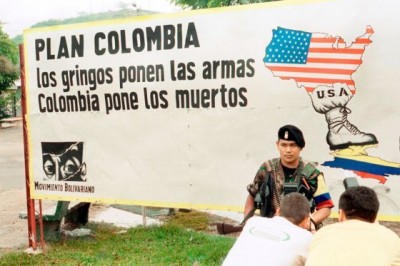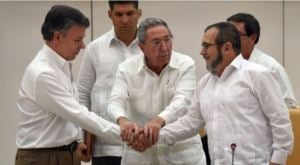Monsanto, the Pentagon’s Soldier and the Colombian “Peace Process”.The Use of Glyphosate Herbicide against the FARC

In a nationwide referendum on the 2nd October 2016 Colombian voters rejected the government’s peace deal with the Revolutionary Armed Forces of Colombia, the biggest extreme-left guerrilla movement (FARC-EP, Fuerzas Armadas Revolucionarias de Colombia – Ejército del Pueblo, FARC).
Negotiations, preceding the sign of the deal, took four years and were seen as a hope to end a half-a-century civil war, that took more than 250 thousands of human lives.
The negative results of the referendum with a narrow margin of 0,5 % were completely unexpected and hit the position of the president – a peacemaker Juan Manuel Santos Calderón. In the course of the last few years he invested all his political capital in negotiations with rebels, despite the lukewarm attitude of the White House towards this peace agreement.

The landmark handshake between Juan Manuel Santos and Timoshenko, with two helping hands from Cuban President Raul Castro. (Justice for Colombia).
For decades Colombia has been some kind of battlefield where the USA try to restrain anti-US tendencies in South America. Washington has been fighting the ideas of neo-marxism, guevarism and Liberation theology, which inspire FARC rebels, as well as other left-wing fractions. However, it’s not widely known that in jungles of Colombia there is another war front – the ecological one.
The USA and the Colombian government accuse the rebels of illegal coca production and under cover of so-called «anti-narcotic war» air-spray the jungle with glyphosate herbicide. This pesticide is made by US corporation Monsanto and widely known under the trademark Roundup. Once reached the ground, it destroys not only coca, but all other plants as well.
The use of Glyphosate in the war against partisans has began in 1980s. And in 1999, after signing anti-drug agreements between Washington and Bogota known as «Plan Colombia», this war method acquired an official status.
According to these agreements, the USA government pledged to fund the purchase of pesticide from Monsanto, to supply the project with specially equipped aircrafts and also to train and arm Colombian commandos in order to protect the aircrafts from possible ground fire.
This is what FARC leader Timoleon Jimenez (his real name is Rodrigo Londoño Echeverria), known as «Timoshenko» among partisans (by the way, he is a graduate of the Peoples’ Friendship University in Russia and is trained as medical doctor), according to his interview with the Colombian newspaper VOZ:
«In the regions, where farm communities live close to coca crops, the government accuses landowners of illegal coca production and under this excuse constantly air-sprays their fields with glyphosate. This chemical destroys coca randomly along with other agricultural crops, causing irretrievable harm to animals and people, especially to children, seniors and pregnant women.»
The partisans try to shoot down US aircrafts loaded with chemical death. To escape the fire, pilots go higher and the glyphosate air-spraying becomes even less precisely aimed.
The FARC’s war against «Monsanto’s air-spray aviation» was used by US secret services to arrange a provocation against Russian businessman Victor But. He was arrested by the US Drug Enforcement Administration in 2008 in Thailand and accused of attempt to sell portable air defense systems to Colombian rebels.
Colombia is the only country in the world where the use of glyphosate happens in such a barbaric style. Millions of liters of toxic herbicide are sprayed over «the lungs of the planet», how they often name tropical rain forests in South America. The country holds one of the first places in the world for biodiversity. It is here almost 10% of all endemic (aboriginal) plant species grow.
More than 6 millions Colombians were forced to leave their homes in the areas affected by glyphosate. It is comparable to the number of refugees from Syrian conflict areas, but Colombia draws considerably less attention of the western mass media.
Number of various diseases, affecting local population, grows progressively, cancer and birth anomalies among them. Soil loses its fertility, forests are being eradicated and water is being polluted.
This makes me think about the Vietnam War, when the Pentagon also widely used the Agent Orange herbicide as a weapon against the Viet Cong, and it was also produced by Monsanto. Around 3 million have suffered illnesses caused by Agent Orange, half a million of them died. The consequences of Agent Orange will likely emerge in the future generations of Vietnamese affected by various inherited diseases.
The lands abandoned by Colombians, because they can’t be used anymore for traditional agriculture, are now under the control of the biotechnology companies with a view to expanding their genetically-modified crops, resistant to glyphosate.
Monsanto has got a carte-blanche from the Colombian government to sell their GM-seeds in the country. It means that these GM-crops would also be consumed by humans and animals. That’s how the war against the Colombian guerrilla movement has led to the concurrent expansion of GM-technology.
In March 2015 the International Agency for Research on Cancer (IARC) of the World Health Organization assigned glyphosate to the group of major risk agents causing human cancer (group 2A). The IARC reports that glyphosate is able to penetrate human cells and to damage DNA and chromosomes.
In May 2015 the National Drug Council of Colombia decided to «suspend using glyphosate spraying as a means to combat narcotics». This moratorium was demanded by FARC representatives at the peace talks in Havana.
The IARC report was a nice excuse for president Santos to make a compromise with the rebels.
Despite the president’s support, the glyphosate moratorium was opposed by the Colombian «war fraction» and its US sponsors, including Juan Carlos Pinzón Bueno, the defense minister, Álvaro Uribe Vélez, the former president and Kevin Whitaker, US ambassador in Bogota. They claimed that it was an undeserved concession to the FARC and called for a continuation of the herbicide air-spraying «for the sake of combating the trade in narcotics».
Of course, it’s not only about coca plantations. The US use the anti-narcotic campaign in Colombia as an easy excuse to eradicate FARC. And vice versa, Washington is surprisingly tolerant to drug production, when it brings in profit.
Let’s take Afghanistan as an example. According to the United Nations Office on Drugs and Crime, this country became the world’s largest heroin producer right after it had been occupied by American forces.
Russia repeatedly suggested to initiate (with the US) a campaign against opium poppy production in Afghanistan. But official US and NATO representatives declined this proposal, because, in their opinion, it might push local peasants to join Muslim fractions and create an additional war threat.
Let’s appraise the situation soberly. Nowadays, the estimated number of active FARC members hardly exceeds 5-6 thousand people. It’s naive to think that several thousand rebels trapped in jungle could retain control of a transnational joint venture known as «the Colombian cocaine industry», worth tens of billions US dollars.
It’s not only left-wing partisans who are involved in the drug-industry, there are also extreme-right «death squadrons» supported by the government, and other militant forces, they all form the core of a powerful drug cartel. Hordes of corrupt bureaucrats, bankers, law enforcement officers are complicit.
It is remarkable, that the FARC leader Timoshenko in his article «About Glyphosate: powerful chemical weapon of transnational power» linked the Pentagon and Monsanto hostilities in the region with «the Colombian money-laundering empire».
«Glyphosate» and «war» became synonyms now in Colombia. That is why the moratorium on the herbicide air-spraying wouldn’t last long. Already in April 2016 the Colombian government under US pressure and on the pretext of fighting the drug trade resumed the use of glyphosate.
The Monsanto aircrafts came back to the Colombian sky and became the Stormcrows, foreboding trouble to the peace talks. The failed referendum in October 2016, could trigger the onslaught of a new and dramatic crisis in Columbia.
As long as it “rains with glyphosate” over Colombian forests, there is no peace to be expected in this country.
Translated from Russian

